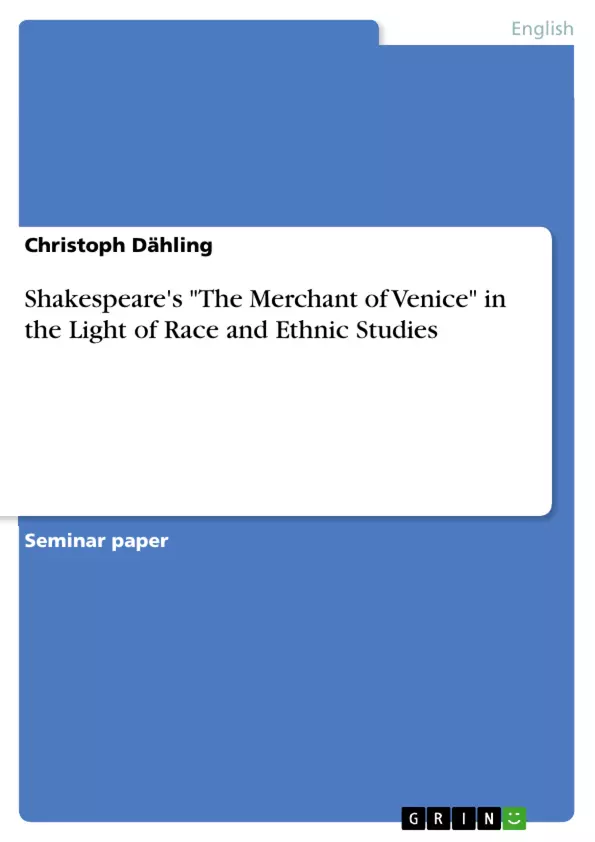Die Arbeit analysiert Shakespeares Stück aus der Perspektive postmoderner Identitätskonzepte aus den Race und Ethnic studies.
Inhaltsverzeichnis (Table of Contents)
- Introduction
- Racism, anti-Semitism and racist discourse
- The candidates for Portia's love
- Jessica
- Shylock
- Racist discourse directed at him
- Racist discourse about him
- Shylock's motifs
- Revenge
- Economical reasons
- Shylock as a stereotype
- Justice
- Conclusion
Zielsetzung und Themenschwerpunkte (Objectives and Key Themes)
The main objective of this paper is to analyze William Shakespeare's The Merchant of Venice through the lens of race and ethnic studies, specifically examining the construction of foreignness in the play and the portrayal of the Jewish character of Shylock.
- Construction of otherness and stereotypes
- Racist discourse and its impact on character portrayal
- The complex relationship between economic motives and prejudice
- The influence of cultural and religious differences on social dynamics
- The role of justice and its application to marginalized individuals
Zusammenfassung der Kapitel (Chapter Summaries)
- Introduction: This chapter provides an overview of the play's enduring fascination and its enduring relevance in light of the Holocaust. It also introduces the paper's focus on utilizing race and ethnic studies to understand the portrayal of foreignness in the play.
- Racism, anti-Semitism, and racist discourse: This chapter defines key terms such as racism, anti-Semitism, and racist discourse, drawing on relevant sources. It lays the groundwork for understanding the underlying themes of prejudice and discrimination that permeate the play.
- The candidates for Portia's love: This chapter examines the portrayal of the suitors for Portia's hand, specifically Morocco and Arragon. It analyzes how their cultural and religious backgrounds are used to present them as foreign and inferior, reinforcing the play's themes of otherness and prejudice.
- Jessica: This chapter focuses on Jessica, Shylock's daughter, and explores her role in the play's depiction of Jewish identity and its intersection with cultural and religious prejudice.
- Shylock: This chapter explores the portrayal of Shylock, analyzing the racist discourse directed at him and about him. It further examines Shylock's motivations, including his desire for revenge and his economic circumstances, within the context of the play's social and political landscape.
- Justice: This chapter investigates the concept of justice in the play, analyzing how it is applied to Shylock and other characters. It examines the tension between legal and moral principles, and how this tension reflects the play's exploration of prejudice and discrimination.
Schlüsselwörter (Keywords)
The key themes of this paper revolve around the intersection of race, ethnicity, and social dynamics in Shakespeare's The Merchant of Venice. This includes concepts such as otherness, prejudice, racist discourse, anti-Semitism, and the complex interplay of economic, cultural, and religious factors. This exploration utilizes key concepts from Race and Ethnic Studies to analyze the play's portrayal of foreignness, prejudice, and the quest for justice.
- Quote paper
- Christoph Dähling (Author), 2010, Shakespeare's "The Merchant of Venice" in the Light of Race and Ethnic Studies, Munich, GRIN Verlag, https://www.grin.com/document/177225



